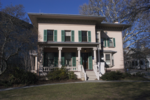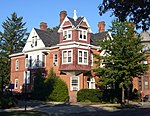St. Mary's Church (New Haven, Connecticut)

St. Mary Church is a Roman Catholic church in New Haven, Connecticut, part of the Archdiocese of Hartford. It is the seat of the city-wide Blessed Michael McGivney Parish. As of July 1, 2023, the consolidated city-wide parish operates eight churches for regularly scheduled worship. The parish now known as Blessed Michael McGivney Parish was the first Catholic parish erected in New Haven, and is the second oldest Roman Catholic parish in Connecticut. The parish was originally established in 1832 as Christ Church Parish, becoming Saint Mary Parish in 1848. The current Saint Mary church building, located on Hillhouse Avenue near Yale University, was dedicated in 1874. In 1882, Michael J. McGivney, the Saint Mary's assistant pastor, founded the Knights of Columbus at the parish. McGivney, whose remains are interred within the church, was beatified by Pope Francis in 2020. For 135 years, from 1886 until their departure in December 2021, St. Mary's parish had been run by friars of the Dominican Order. In 2021, priests from the archdiocese were assigned to Saint Mary Parish as part of second major restructuring of parishes in New Haven. On July 1, 2023, all parishes within the city of New Haven were formally merged into Saint Mary Parish to form Blessed Michael McGivney Parish. In 2018, the parish of St. Mary had previously merged with nearby St. Joseph Parish as part of an earlier diocesan-wide restructuring. The churches constituting the city-wide parish include: Saints Aeden and Brendan Church, Saint Anthony Church, Saint Francis Church, Saint Joseph Church, Saint Mary Church, Saint Michael Church (Italian), Saint Thomas Moore Chapel at Yale, Saint Martin de Porres Church, and Saint Stanislaus Church (Polish). Saint Bernadette Church, though within the city of New Haven, is part of St. Pio of Pietrelcina Parish of East Haven, Connecticut. A separate Eastern Catholic parish of Saint Michael, part of the Ukrainian Eparchy of Stamford, also exists within New Haven.
Excerpt from the Wikipedia article St. Mary's Church (New Haven, Connecticut) (License: CC BY-SA 3.0, Authors, Images).St. Mary's Church (New Haven, Connecticut)
Hillhouse Avenue, New Haven
Geographical coordinates (GPS) Address Nearby Places Show on map
Geographical coordinates (GPS)
| Latitude | Longitude |
|---|---|
| N 41.3119 ° | E -72.924 ° |
Address
Saint Mary's Church
Hillhouse Avenue 5
06511 New Haven
Connecticut, United States
Open on Google Maps






